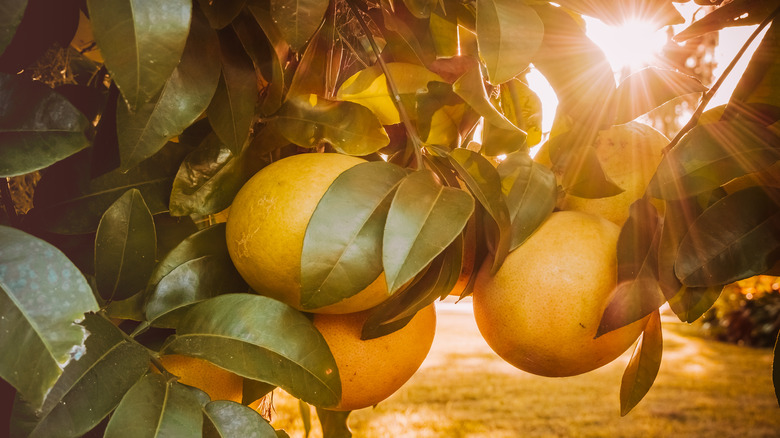Grapefruits Are Actually A Hybrid Of These 2 Fruits
The family trees of citrus fruits are, well, a bit interbred. But there's a reason, of course: Atlas Obscura tells us that citrus hybridizes easily, meaning that genetic matter from different varieties of citrus fruit can combine — either naturally or due to deliberate crossbreeding — and form entirely new kinds of fruit. Citrus fruits are ancient, according to Wide Open Eats, which explains that fossilized citrus leaves that are roughly seven million years old have been found in China. Citrus fruits were born in the humid regions of Asia, though they've spread across the globe, where they thrive in warm climates.
Three citrus species, all native to southeast Asia, are the progenitors of the citrus fruits we know and enjoy today. The citron, pomelo, and mandarin are the parents and grandparents of most of what we find in grocery stores. When you're enjoying a paloma, you're sipping juice from a fruit with a complicated and confusing history.
Where did grapefruit come from?
The grapefruit is widely believed to have originated in Barbados, according to the American Society for Horticultural Science, and as citrus fruit goes, it's a relative young'un, as it's only about 300 years old. Atlas Obscura explains that the grapefruit is a hybrid of the pomelo and the sweet orange. The sweet orange, naturally, is a hybrid as well, a cross between a pomelo and a mandarin.
Though the fruit itself is around 300 years old, the name "grapefruit" doesn't appear until around the 1830s, according to Atlas Obscura. Of course, grapefruit doesn't taste anything like grapes, and in the late 1600s, when the fruit probably appeared, there were no grape vines planted on the island. It's likely that the "grapes" for which the grapefruit was named were sea grapes (confusingly, a member of the buckwheat family). Sea grapes are sour and bitter, not unlike the flesh of the grapefruit.
Currently, the state of Florida produces the most grapefruit in the U.S. and there are a number of different varieties, many bred for sweetness and seedlessness.

